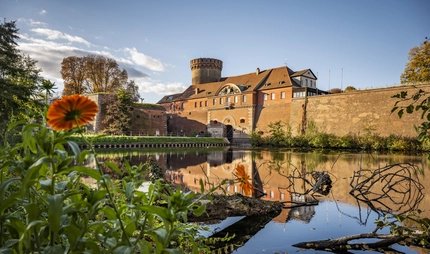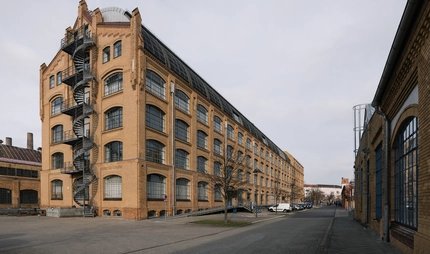
Bayerische Motorenwerke
Modern Industrial Buildings in Spandau
In the far west of Berlin, on the site of today’s BMW motorcycle plant, you will find industrial buildings from the beginning of the 20th century.
The history of the armaments industry in Spandau dates back to the 18th century. At that time, the Prussian government relocated its arms production to Haselhorst. After the end of the First World War, production collapsed due to the ban on weapons then in force, but the name Gewehrfabrik remained.
New Aesthetics for Industrial Buildings
In the 19th century, many industrial façades were decorated with elaborate historicist embellishments. From the turn of the century onwards, more and more architects moved away from this contemporary taste. In 1911, for example, the Berlin architect Hans Poelzig said that the greatest task of a planner of industrial buildings was “the renunciation of all coincidences, of all bizarre decorative elements”.
At the beginning of the 20th century, the construction of new industrial plants offered the opportunity to test new shapes and spatial effects. One of the best-known examples was the AEG turbine factory built in 1909 by Peter Behrens in Moabit. It was Berlin’s first industrial building with a functionalist façade.
Factory Halls and Administration Building at the Juliusturm tower
In the early decades of the 20th century, new industrial buildings were erected in Haselhorst against a historical backdrop. Near the Spandau Citadel and the medieval Juliusturm tower, you can still find various buildings that express the new aesthetics of this period.
Standing side by side directly on the Am Juliusturm street are seven factory halls dating back to around 1918, whose architecture is in the New Objectivity style. They have arched roofs and fronts streaked with glass windows. The façades are clad with reddish brown tiles, while skylights are installed on the roofs to provide better lighting conditions during work.
The four-storey administration building from 1918 is also made of bricks. It reveals a striking contrast between the objective shapes of the windows and the historical allusions on the narrow sides of the building: here the uppermost floor forms a triangular pediment.
Hans Hertlein, who was head of construction at Siemens AG at the time, oversaw the hall expansions on the site in 1937. They were designed in clear forms: rectangular brick buildings with evenly arranged rows of windows, with the metal and glass saw-tooth roofs being a special feature.
Haselhorst as a BMW Site
In 1939, Bayerische Motorenwerke took over the site. During the Second World War, the factory halls were used to manufacture aircraft engines. During this time, 10,000 people worked for BMW in Haselhorst. After the war, production was limited for a short time to tools such as sickles, scythes and knives. From 1969, the BMW Group relocated its entire motorcycle production to Haselhorst.
Our tips for nearby the Gewehrfabrik Haselhorst
Haselhorst offers other exciting sites of Berlin Modernism. One example is the Reichsforschungssiedlung Haselhorst on Burscheider Weg, which was built between 1930 and 1935 to create affordable housing for Berlin workers. Take the U-Bahn line 7 from the Haselhorst station on Siemensdamm to the Siemensstadt Housing Estate. It features buildings by Hans Scharoun and Walter Gropius and is a UNESCO World Heritage Site.
Practical information from visitBerlin
You can reach the Gewehrfabrik Haselhorst by taking the U-Bahn line 7 to the Haselhorst station. To explore the city, we recommend the Berlin WelcomeCard for public transport.


